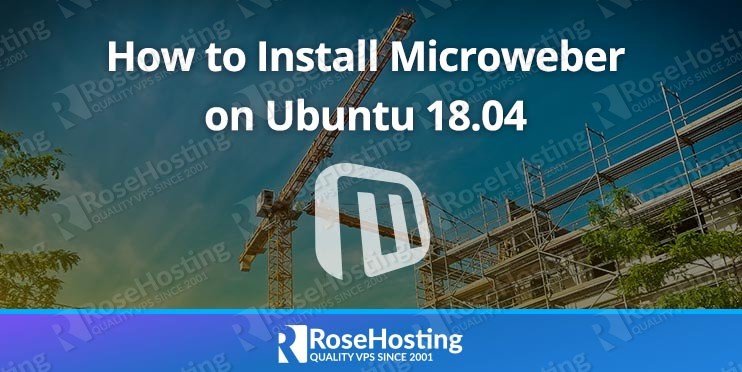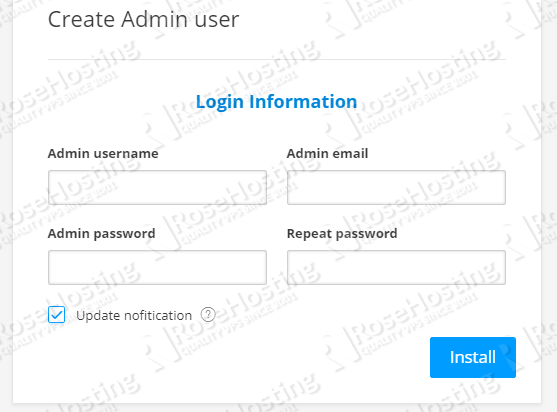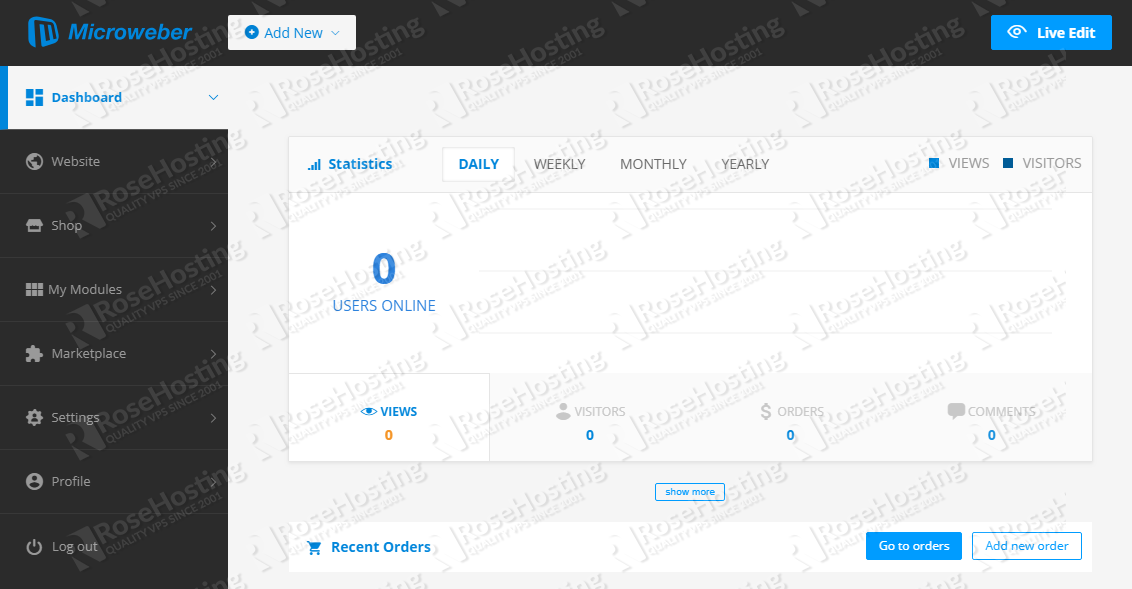Microweber is a feature-rich open-source content management system and website builder. It is based on the PHP programming language and the robust Laravel Java framework. Microweber’s drag-and-drop technology and real-time writing and text editing functionality provides a quick and easy way to create your content, helping turn your website into a rich environment for you to express your thoughts. It also comes with built-in storefront features, allowing you to create an e-commerce site from which you can sell your products on the Internet.
In this tutorial, we will show you how to install Microweber on an Ubuntu 18.04 VPS.
Table of Contents
Requirements:
- For the purposes of this tutorial, we will be using an Ubuntu VPS.
- You will also need a working LAMP or LEMP (Linux, Apache/Nginx, MySQL, PHP) stack. Our Ubuntu 18.04 VPS already comes pre-installed with a fully-configured LAMP stack.
- Full SSH root user access or a user with sudo privileges is also required.
Step 1: Connect to Your Server
Before we begin, you will need to connect to your server via SSH as the root user or as any other user that has sudo privileges.
To connect to your server as the root user, use the following command:
ssh root@IP_ADDRESS -p PORT_NUMBER
Make sure to replace IP_ADDRESS and PORT_NUMBER with your actual server IP address and SSH port number.
Once logged in, make sure that your server is up-to-date by running the following commands:
sudo apt update sudo apt upgrade
Always keep your system updated. You can also set up automatic updates.
Step 2: Install Apache
Apache is a fast and secure web server – it is one of the most popular and widely used web servers in the world.
To install Apache on your Ubuntu 18.04 server, run the following command:
sudo apt install apache2
Once the installation is complete, enable the Apache service to start automatically upon system boot. You can do that with the following command:
sudo systemctl enable apache2
To verify that Apache is running, execute the following command:
sudo systemctl status apache2
Output:
● apache2.service - The Apache HTTP Server
Loaded: loaded (/lib/systemd/system/apache2.service; enabled; vendor preset: enabled)
Drop-In: /lib/systemd/system/apache2.service.d
└─apache2-systemd.conf
Active: active (running) since Thu 2019-03-28 04:47:47 CDT; 7min ago
Main PID: 843 (apache2)
Tasks: 6 (limit: 2320)
CGroup: /system.slice/apache2.service
├─843 /usr/sbin/apache2 -k start
├─868 /usr/sbin/apache2 -k start
├─869 /usr/sbin/apache2 -k start
├─871 /usr/sbin/apache2 -k start
├─872 /usr/sbin/apache2 -k start
└─873 /usr/sbin/apache2 -k start
You can also open your web browser and enter your server’s IP address, (e.g. http://your-ip-address). If Apache was successfully installed, you should see a message in your web browser saying “It works!”.
Step 3: Install MySQL
The next step is to install MySQL. It is one of the most popular database management systems.
To install MySQL on your system, type the following command and enter the character ‘Y’ when prompted:
sudo apt install mysql-server
During the installation, you will be asked to enter a password for the MySQL root user. Make sure to enter a strong password.
To further improve the security of our MySQL installation as well as set up a password for our MySQL root user, we need to run the mysql_secure_installation script and follow the on-screen instructions. Run the command below to configure your system:
sudo mysql_secure_installation
If the program asks you to enter your current MySQL root password, just press your [Enter] key once, as no password is set by default when installing MySQL.
A few more questions will be displayed on-screen – it is recommended that you answer yes to all of them by entering the character ‘Y’:
Remove anonymous users? (Press y|Y for Yes, any other key for No) : Y Disallow root login remotely? (Press y|Y for Yes, any other key for No) : Y Remove test database and access to it? (Press y|Y for Yes, any other key for No) : Y Reload privilege tables now? (Press y|Y for Yes, any other key for No) : Y
Again, we can enable MySQL to start on boot with the following command:
sudo systemctl enable mysql
That’s it – MySQL has been installed and made more secure.
Step 4: Install PHP
The last step of our LAMP stack setup is to install PHP. Ubuntu 18.04 comes with PHP 7.2 by default.
We will also include some additional modules in order to help PHP to connect with our Apache and MySQL servers. On top of these, we will install modules that are required by our Microweber site.
To do this, type the following command:
sudo apt install php7.2 libapache2-mod-php7.2 php7.2-common php7.2-mysql php7.2-cli php7.2-opcache php7.2-gd php7.2-curl php7.2-cli php7.2-imap php7.2-mbstring php7.2-soap 7.2-xmlrpc php7.2-xml php7.2-zip
To test whether PHP has been set up correctly, we will create a file called info.php. Place this file inside the web server root directory.
Open your text editor:
sudo nano /var/www/html/info.php
Enter the following lines and save the file:
<?php phpinfo(); ?>
Restart the Apache server by typing:
sudo systemctl restart apache2
Now, if you navigate to this page: http://your-ip-address/info.php in your web browser, you will see the following page showing your current PHP configuration:
This means that PHP has been set up correctly and is working properly.
Step 5: Install Microweber
We can now start with our Microweber installation and configuration.
First, we need to create a new database. To do this, log in to your MySQL database server as the root user by typing the following command:
sudo mysql -u root -p
To create a new database and user, run the following commands on the MySQL shell:
CREATE DATABASE microweber;
CREATE USER microweber@localhost IDENTIFIED BY 'strong-password';
GRANT ALL PRIVILEGES ON microweber.* TO microweber@localhost;
FLUSH PRIVILEGES;
Make sure to replace strong-password with an actual strong password.
To exit the MySQL database server command line, type:
exit
Next, let’s create a new directory for our Microweber site:
sudo mkdir /var/www/microweber
We can now download the latest Microweber version from the official site. You can do this with the following command:
wget https://microweber.com/download.php -O latest.zip
To extract the file in our Microweber directory, execute the following command:
sudo unzip latest.zip -d /var/www/microweber
The owner of the files needs to be the user of the web server running on your system. In our example, we are using the Apache web server and Apache runs under the “www-data” user on Ubuntu. To change the owner of the files, you can then run the following command:
sudo chown -R www-data:www-data /var/www/microweber/
Step 6: Configure Apache
In this step, we will show you how to create a virtual host file for Apache – this is so you can access your Microweber installation using your domain name.
Create the virtual host file by executing the following command:
nano /etc/apache2/sites-available/microweber.conf
And enter the following information:
<VirtualHost *:80>
DocumentRoot /var/www/microweber
ServerName mydomain.com ServerAlias www.mydomain.com <Directory /var/www/microweber/> Options FollowSymlinks AllowOverride All Require all granted </Directory> ErrorLog ${APACHE_LOG_DIR}/microweber_error.log CustomLog ${APACHE_LOG_DIR}/microweber_access.log combined </VirtualHost>
Make sure to replace mydomain.com with your actual domain name.
To enable the new Microweber virtual host, run the following command:
sudo a2ensite microweber.conf
You should see the following output:
Enabling site microweber. To activate the new configuration, you need to run: systemctl reload apache2
You also need to enable the Apache mod_rewrite module. You can do this with the following command:
sudo a2enmod rewrite
Reload your Apache in order to activate the new configuration:
sudo systemctl reload apache2
Step 7: Accessing Microweber
You can now open your preferred web browser and access your Microweber installation at http://mydomain.com (of course, make sure to replace mydomain.com with the actual domain name you used when creating the Apache virtual server block).
This will take you to the initial setup page for Microweber.
You will first need to enter your Database Server information, including the MySQL username, password for the user, and database name that we created for our Microweber website:
You can also choose a template for your website:
The last step is to create an Admin user:
After you are finished entering all of the required information, click the “Install” button. After a few seconds, the Microweber installation will be completed, and you can access your admin panel and start building your website.
That’s it! Microweber has been successfully installed on your Ubuntu 18.04 server.
Of course, you don’t have to install Microweber on Ubuntu 18.04 if you have a Managed Ubuntu Server with us. You can simply ask our support team to install Microweber on Ubuntu 18.04 for you. They are available 24/7 and will be able to help you with the installation.
PS. If you enjoyed reading this blog post on how to install Microweber on Ubuntu 18.04, feel free to share it on social networks using the shortcuts below, or simply leave a comment in the comments section. Thanks.




